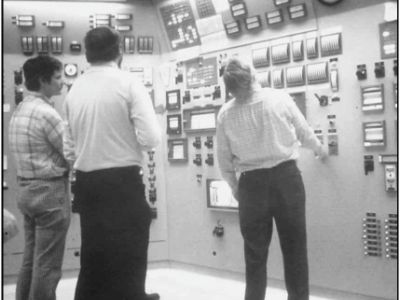Picture this: It is Aug. 28, 1975. The Vietnam War has just ended, gas is 44 cents a gallon, and “Get Down Tonight” by KC and the Sunshine Band is the top hit on the charts.
And on the shores of Lake Michigan, D.C. Cook Nuclear Plant begins generating electricity in reactor Unit 1.
In the 50 years since, Unit 1 has generated more than 339 million megawatt hours of safe, reliable, emission-free power; countless memories for thousands of employees; and a strong foundation for AEP’s nuclear future.
“This milestone is a testament to our incredible team’s dedication and commitment to safety,” said Kelly Ferneau, Executive Vice President and Chief Nuclear Officer. “Together, we power the future with pride in our work and unwavering integrity.”
Ferneau has had a lifelong passion for nuclear power, and especially Cook Plant. More than a decade of her career has been spent at the same plant she first visited during a high-school field trip.
“After that trip, I knew I wanted to work in nuclear power,” she said.
Scott Dailey, site vice president, echoed Ferneau’s sentiment.
“I am incredibly proud to celebrate the 50th anniversary of operation for Cook Nuclear Plant Unit 1,” Dailey said. “This milestone is a testament to the unwavering dedication and support from American Electric Power and Indiana Michigan Power leadership, the exceptional efforts of the Cook staff, and the strong partnership with our community. Together, we have achieved remarkable success and ensured a sustainable future for generations to come."
Looking Forward
Cook has been a proving ground for AEP. Over decades, AEP employees have forged the expertise and demonstrated the capability to build and operate the most reliable form of emission-free power on the planet.
As we look to the future, Cook Plant will remain a safe, reliable and efficient source of power for customers as we work to develop and operate the next evolution in nuclear power: Small Modular Reactors.
“During the last 50 years, the Cook team has demonstrated its dedication to safety and operational excellence. Every Cook Plant employee, past and present, deserves to be commended for their work,” said Bill Fehrman, AEP President and CEO. “Nuclear power will be critical to meeting future energy needs and achieving energy independence. The achievements of Cook serve as the foundation as we seize a generational opportunity to lead the industry in advanced nuclear energy development.”
We are strategically advancing potential SMR projects in Virginia and Indiana, and are actively engaged with stakeholders around these exciting initiatives.
Cook’s experts possess the deep knowledge to help us successfully deploy this new technology and develop training, operations plans and leadership programs. As we build upon Cook’s legacy, one thing is clear: the achievements of the past 50 years are just the beginning.
“I’ve learned that milestones like this are built on generations of teamwork and dedication,” said Chad Britton, managing director of engineering at Cook. “What's impressive is that this legacy continues to build one shift, one challenge, and one act of teamwork at a time.”
Currently, Cook’s two reactor units have licenses to operate through 2034 and 2037. We have submitted a notice that we intend to pursue license renewal for the plant beyond those dates.
“With the way the plant has been maintained, there is no reason not to expect D.C. Cook to continue to safely and reliably operate for many decades to come,” Plant Manager Luke Ellis said.
Echoes of the Past
Cook Plant began operations shortly before the retirement of its namesake, Donald C. Cook, who served as AEP’s chairman from 1962 to 1976. Born in Michigan, Cook worked for AEP for 23 years and passed away in 1981.

The man at the controls during the first nuclear chain reaction was Kayo Murphy, one of the many early Cook employees recruited from the company’s coal fleet. Murphy remembered his time at Cook clearly and was very proud of the early days of plant operation.
“The Unit 1 control room was packed with people – bosses, local politicians and on-lookers,” Murphy recalled in a 2010 interview. “We knew it was a big deal, and we all signed the original source range neutron count rate strip chart and got a copy. I still have mine today.”
The original plant manager was Bob Jurgensen.
“Three of us from AEP joined a small group of people from five utilities to study nuclear power in Chicago at Argonne Labs from 1953 to 1955,” Jurgensen recalled. “When AEP decided not to build a nuclear plant right away, I went back to Kammer Plant. Then in 1959 they called me to New York, and we began the work of designing and building Cook.”
Cook Plant’s Community Impact
In the years since Cook Plant’s Unit 1 and Unit 2 went online, Cook Plant has powered the community in many ways.
- Cook can generate 2.2 gigawatts of electrical output – enough to power 1.5 million homes.
- Hundreds of supplemental workers flock into town during spring and fall refueling outages, boosting the local economy.
- Educational outreach programs bring employees into the classroom to help students understand the science of nuclear power and its benefits.
- Millions of dollars have funneled into hundreds of worthy nonprofit organizations.
- Cook’s extensive Emergency Response Organization trains regularly alongside local, state and federal organizations ensuring a strong partnership with Berrien County.
As we celebrate this 50-year milestone, we recognize Cook Nuclear Plant’s Unit 1 as not only a cornerstone of our past but a beacon guiding us toward a sustainable energy future. Together, we will continue to innovate and lead the way into the next generation of nuclear energy.









